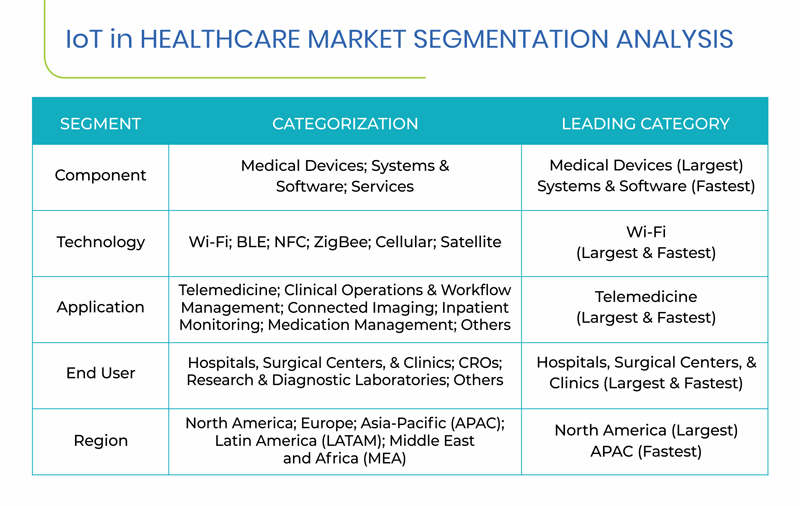IoT in Healthcare Market to Generate Revenue Worth $267.6 Billion by 2023
- Published: June 2018
The global internet of things (IoT) healthcare market valued $56.1 billion in 2017 and is expected to reach $267.6 billion by 2023, witnessing a CAGR of 30.2% during the forecast period (2018–2023). Among all components, medical devices held the largest share in the market in 2017. Further, in the category of medical devices, wearable external devices contributed the highest revenue to the market.
Increasing Collaborations among Players - A Major Trend in the Market
One of the major trends observed in the IoT in healthcare market is the active involvement of key players in collaborations and partnerships that are focused on providing advanced IoT solutions to healthcare organizations. For instance, in January 2018, General Electric Company signed a strategic, long-term partnership with F. Hoffman-La Roche Ltd. for the joint development and co-marketing of digital clinical decision support solutions. The partnership focused on the development of products that would improve individualized treatment for critical care patients. Similarly, in January 2018, Koninklijke Philips N.V. entered into a multi-year partnership agreement to install Philips Tasy electronic medical record (EMR) systems in VPS Healthcare hospitals and clinics across India, Oman, and the U.A.E.
Rising Investments for IoT in Healthcare to Drive the Market
Increasing government funding and rising private investments in IoT are playing a pivotal role in the growth of the IoT in healthcare market, globally. For instance, the U.K. government invested $52.8 million in IoTUK, its three-year national program for the development of the IoT network in the country. Besides, several government organizations are taking initiatives to boost the adoption of IoT solutions in healthcare. For instance, the U.S. federal government enacted various legislations, such as the Affordable Care Act (ACA) and the Health Information Technology for Economic and Clinical Health (HITECH) Act, to promote the adoption of EHR solutions in the healthcare sector. These legislations also offer incentives to healthcare providers for EHR adoption, workforce training, and infrastructural improvement. Similarly, the ACA supports medication management programs for improved healthcare in the U.S.
Segmentation Analysis of IoT in Healthcare Market

- Medical devices held the largest share in the IoT in healthcare market in 2017. These IoT-enabled devices monitor and analyze patients’ medical conditions and timely notify caregivers about the condition for further treatment.
- The Wi-Fi technology is expected to dominate the market throughout the analysis period, owing to its high adoption across the world. The technology-supported healthcare IoT solutions facilitate continuous patient monitoring, reduced hospital visits, and improved healthcare outcomes.
- Furthermore, IoT solutions are expected to witness the highest demand in telemedicine, registering a CAGR of 32.1% during the forecast period. This can be mainly ascribed to high adoption of IoT-supported telemedicine platforms to improve the quality of patient care while lowering the cost of healthcare delivery.
- Hospitals, surgical centers, and clinics, as an end-user category, are expected to generate the highest demand for IoT solutions during the forecast period. This can be mainly attributed to the increasing number of hospitals and clinics across the world.
Geographical Analysis of IoT in Healthcare Market
Globally, North America accounted for the largest share in the IoT in healthcare market, contributing 44.3% revenue in 2017. This can be mainly ascribed to the growing prevalence of chronic diseases, increasing initiatives by government and non-government organizations to increase awareness and boost the adoption of IoT solutions in healthcare, advancements in technology, and growing R&D activities in the healthcare information technology (HIT) sector in the region.
The IoT in healthcare market, during the forecast period, is expected to witness the fastest growth in APAC. This can be attributed to the high prevalence of chronic diseases, increasing geriatric population, and rising investments in the healthcare sector in the region. In 2017, China held the largest share in the APAC IoT in healthcare market, mainly on account of the surge in geriatric population and various initiatives by government organizations in the field of IoT in the healthcare industry of the country.
In LATAM, the IoT in healthcare market is expected to witness the fastest growth in Brazil, driven by IoT-related initiatives by the Brazilian government. For instance, the Brazilian government launched the IoT National Action Plan, for which the Ministry of Science, Technology, Innovation and Communication (MCTIC) and the Brazilian Development Bank (BNDES) announced a set of initiatives to develop and accelerate the adoption of IoT in Brazil.
South Africa is expected to hold a substantial share in the MEA IoT in healthcare market during the forecast period. The market growth in the country is mainly propelled by the rising investments in the IoT technology by key market players and increasing government initiatives to improve healthcare facilities.
Competitive Landscape of IoT in Healthcare Market
The global IoT in healthcare market is consolidated in nature, with major companies focusing on the launch of advanced technology solutions for improved healthcare. Among them, Medtronic plc, Stanley Black & Decker Inc., and Proteus Digital Health Inc. are mainly focusing on medical device components (especially wearable sensors), mHealth applications, and health analytics solutions.
In April 2018, Koninklijke Philips N.V. and Proteus Digital Health Inc. introduced Shinefly, a teleradiology application and service platform that offers a customizable, scalable cloud-based image management solution for storing, viewing, retrieving, and analyzing medical images remotely. The platform supports advanced clinical applications in neurology, cardiology, and oncology.
Similarly, in November 2017, Medtronic plc launched a telehealth solution comprising disease management protocols and patient engagement platforms for meeting complex needs in patient care. The launch was in view of the national contract awarded to the company by the U.S. Department of Veterans affairs (VA) for Home Telehealth Devices and Services.